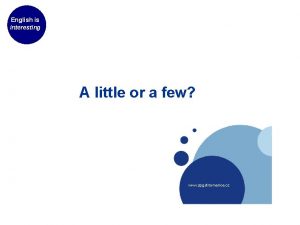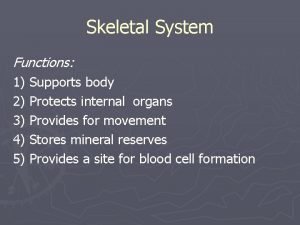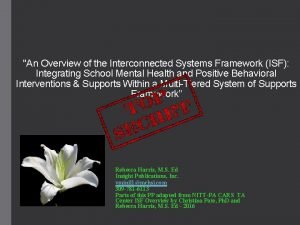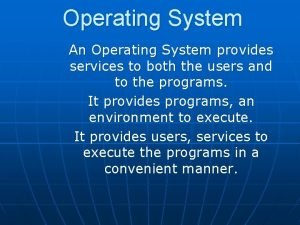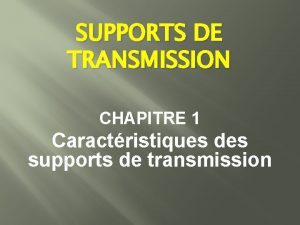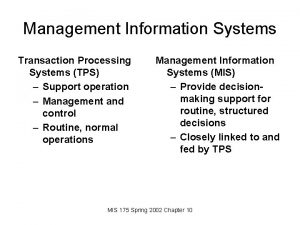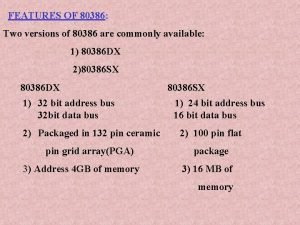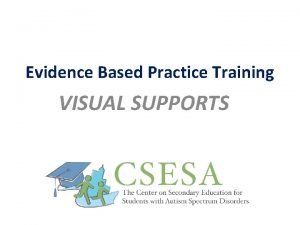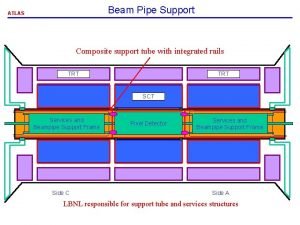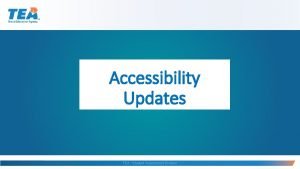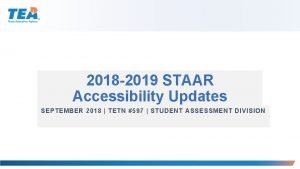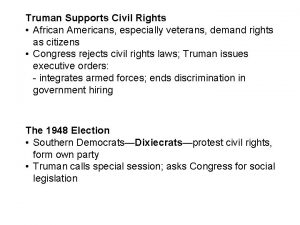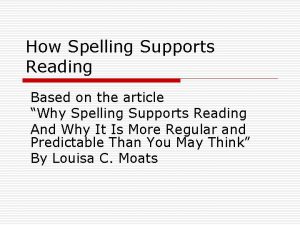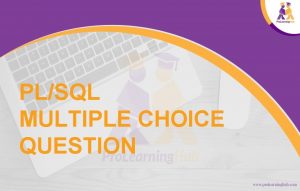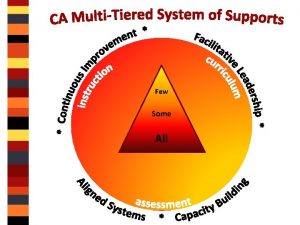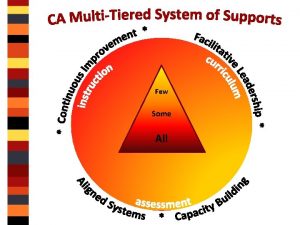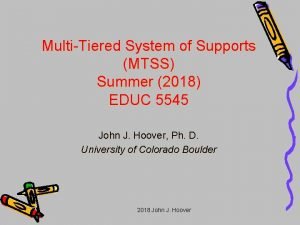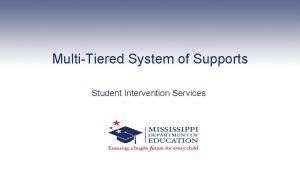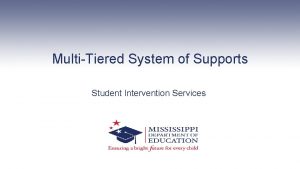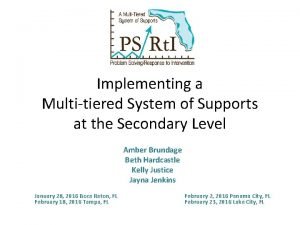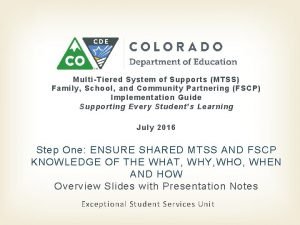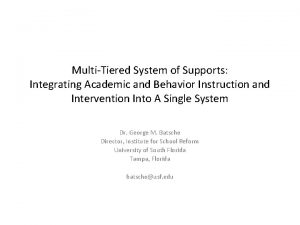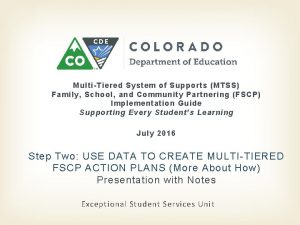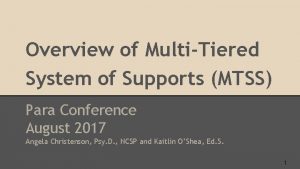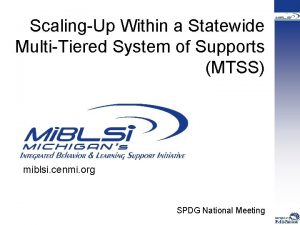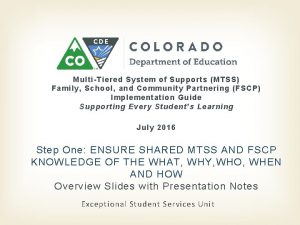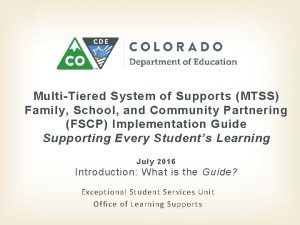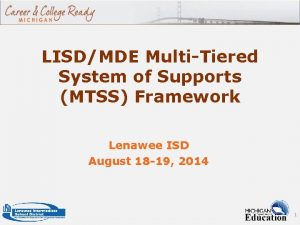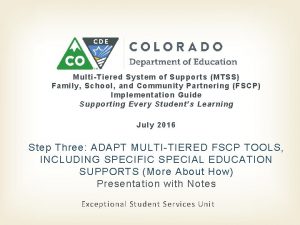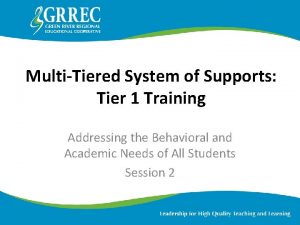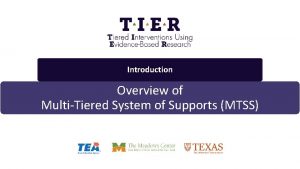Few Some All MultiTiered System of Supports A











































- Slides: 43

Few Some All

Multi-Tiered System of Supports A Comprehensive Framework for Implementing the California Common Core State Standards Professional Learning Module Series d • Unit 1: What is a Multi-Tiered System of Supports? • Unit 2: Data-based Decision Making • Unit 3: Instructional Planning and Supports • Unit 4: Leadership for Implementation of MTSS

Learning Objectives By the end of this unit, you will be able to: 1. State the rationale for data-based decision making in MTSS 2. Define and describe the importance of universal screening and progress monitoring 3. Identify resources for screening and progress monitoring 4. Describe strategies for analyzing data to guide intervention

Unit 1 Take Away Activity Multi-Tier System of Support (MTSS) By: Orla Higgins Averill, Claudia Rinaldi, Urban Special Education Leadership Collaborative Using the graphic organizer in your Unit 2 Participant Packet, note: – Features of Rt. I – Features of PBIS – Features of MTSS – Steps necessary to bring MTSS to scale

Review of Unit 1 Take Away Activity Rt. I PBIS Multiple tiers of intervention service delivery Problem-solving method Data-based decision making behavioral supports Utilizes integrated data collection and an assessment system to make informed decisions at each tier of service delivery Universal screening of all students Multi-tiered, data-based approach to MTSS Bringing MTSS to Scale PBIS • Further integrates a continuum of system-wide resources, strategies, structures, and practices to offer a comprehensive and responsive framework for systemically addressing barriers to student learning • Requires all district staff to change the way they have traditionally worked. • Leverages the principles of Rt. I and

Time to Reflecting on your district or school • What data for academics and behavior is being consistently collected? • How is that data currently being used to guide services and supports? • What additional data would be helpful to you as you plan to deliver instruction?

Essential Rt. I Components (NCRTI)

Essential Concepts CA MTSS Rt. I 2 • Universal screening • Multiple tiers of intervention • Data-driven decision making • Problem solving teams • Focus on CCSS • Addresses the needs of ALL Students • Aligns the entire system of initiatives, supports, and resources • Implements continuous improvement processes at all levels of the system

Data-Based Decision Making: It’s Not Just For Individual Students District Level • Objective data on student progress is used to – Guide curriculum improvement – Help educators recommend innovations and make decisions on how to sustain practices – Support targeting services and supports across schools – Guide the allocation of resources for professional development

District Level Box and Whisker Graph 90 th %ile 200 75 th %ile 50 th %ile 175 25 th %ile 150 10 th %ile 100 Target School A 75 School B 50 School C School D 25 School E Grade 1 Grade 2 Grade 3 Composite

Data-Based Decision Making: It’s Not Just For Individual Students School Site Level • Objective data on student progress is used to – Examine school and grade level trends – Help determine the effectiveness of the curriculum and the fidelity of the instructional delivery

School Level Words Read Correctly Analyzing Growth by Ethnic Groups 140 Caucasian 120 Unidentified 100 Target Scores 80 Hispanic/Latin o 60 African American 40 Asian 20 Fall Winter Spring

Data-Based Decision Making: It’s Not Just For Individual Students Grade/Course Level • Identify trends in academic and social/behavioral areas in order to: – Adjust instruction – Evaluate the effectiveness of the curriculum at that grade level – Set grade level goals – Identify students who need additional assessment or instruction

Grade Level Analyzing Effects of Changes to Instruction Did Not Meet Criteria (Need More Intense Intervention) 100 90 80 70 Percent 60 15 47 32 Did Not Meet Criteria (Need Some Intervention) 50 40 30 53 53 53 80 20 10 Fall Winter Spring Met Criteria for Established Benchmark

Universal Screening • Evaluates whether students are on an appropriate learning trajectory • Conducted with all students • Answers the questions – Is the core curriculum and instruction effective for all students? – What additional assessments and/or instructional supports might be needed? • Addresses both academic and behavioral performance

Academic Achievement Screening Purpose – Identify which students might need additional supports Focus – All students Tools – Brief, valid, reliable, and evidence-based Timeframe – Multiple times a year • Typically fall, winter, and spring

Behavior Screening • • • Attendance Grades Discipline referrals Teacher checklists Teacher referrals

Cut Score • A score on a screening test that divides students who are considered potentially “at risk” from those who are considered not “at risk” Cut scores used to identify students as “at risk” may not be the same Method used to identify students who need supplemental support (National Center on Response to Intervention)

Establishing Cut Scores http: //www. youtube. com/watch? v=l 0 l. Lk. Dic. XZA (National Center on Response to Intervention)

Establishing Cut Scores • Educationally relevant • Based on logical practices • Based on the likelihood of demonstrated mastery of core testing – Benchmark testing • Teams should ask: – Do the screening tools we are using include national norms to establish cut scores? – Do we have local norms from our own assessments that could be used as cut scores?

Benefits of District-Established Cut Scores • May lead to more effective and efficient allocation of resources • Allows district education teams to: – Target schools with the greatest need – Identify effective approaches for scaling up in other sites – Make decisions about resources that are based on data – Make decisions about resource allocation that are relevant and timely

Benefits of District-Established Cut Scores • Increased use of data by schools and teachers • Common message and focused activities • Expectations across sites are clear and consistent • Focus is on progress • Increased access to supplemental supports

Universal Screening Resources Screening Tools Chart: http: //www. rti 4 success. org/screening. Tools/ (National Center of Response to Intervention)

Progress Monitoring • Systematic method for tracking and comparing learning progression through data collection • Involves a set of assessment procedures that determine the extent to which students are benefitting from instruction • Evaluates the effectiveness of instruction • Can be implemented with individual students or an entire class

Progress Monitoring Purpose – Monitor students’ response to interventions in order to • Estimate rates of improvement • Identify students who are not making progress • Compare the success of different forms of instruction Focus – Students who have been identified as “at risk” through the screening process Tools – Brief, valid, reliable, and evidence-based Timeframe – Monthly, weekly, or biweekly

Student Progress Data Should answer the following questions: • Are students making progress at an acceptable rate that will allow them to meet the content standards? • Are students meeting both short-term and long-term performance goals? • Can the effectiveness of the intervention be supported by data and graphed? • Does the instruction or intervention need to be adapted or changed?

Types of Progress Monitoring Diagnostic – Conducted before instruction – Measure current knowledge and skills for the purpose of planning instruction Formative – Conducted during instruction – Tell how well students are responding to instruction Summative – Conducted after instruction – Tell what a student has learned

Identify Students Not Making Adequate Progress Increasing Scores: Flat Scores: Trend line Goal line X X X Trend line (NCRTI “What Is Progress Monitoring? ” module 2012)

Progress Monitoring Resources Progress Monitoring Tools: http: //www. rti 4 success. org/progress. Monitoring. Tools/ (National Center of Response to Intervention)

Types of Decisions The Site Implementation Leadership Team asks: – How effective is the instruction? – What instructional changes need to be made? – Are the supports provided in Tiers 2 and 3 successful for individual students? – When should the team recommend additional assessments for possible identification of a disability? – How does the team know the overall effectiveness of the core curriculum, instruction for all students, interventions, and the MTSS framework?

Decision Making Routines & Procedures The District Implementation Leadership Team should establish • “Non-negotiable” areas in order to establish equity and consistency across the district • Site level procedures and routines for the grade/course level teams to use when conducting data reviews • Decision making processes • Explicit decision rules for assessing student progress

Explicit Decision Rules Define what will guide the team when • Less than 80% have reached the cut score • Lack of progress is evident • Student progress varies by target group Decision rules should be established at all levels

Data Reviews • Conduct data reviews at logical, predetermined intervals • Schedule data reviews prior to the beginning of instruction • Use established meeting structures • Involve relevant team members

Problem-Solving Process “…Problem-solving is a self-correcting, decision-making model focused on academic and/or behavioral intervention development and monitoring using frequently collected, measurable data on student performance. The problem-solving process should be rich in data collected, and can be repeated as necessary. ” (The New Hampshire Response to Instruction Framework, 2012)

Continuous Improvement Problem-Solving Process 1. Plan 5. 2. Communicate 4. Act Do 3. Study

1. Plan Collect and analyze data Define the problem Develop a plan of action Define the evidence-based interventions that will be used • Assign responsibilities to individual team members • Identify the necessary materials and resources • Create an implementation timeline • •

2. Do • Implement the plan with fidelity • Collect progress monitoring data to determine academic and behavioral success • Examine the fidelity of the implementation

3. Study • Analyze the progress monitoring data collected to determine the fidelity of implementation • Determine if – The student is making sufficient progress – The instruction or intervention is effective

4. Act • Make any necessary refinements to the plan to improve the chance of success • Might involve – Increasing the intensity of intervention – Adjusting resources – Increasing expectations – Deciding that the student will benefit from less intensive intervention

5. Communicate • Routine and frequent information sharing • Communicate successes, challenges and lessons learned All teams have information that is useful in ensuring that MTSS is effective and sustainable

Take Away Activity • Reflect on the data-driven instructional planning elements in your setting: – How do universal screening and progress monitoring occur? – Are teams established to examine student data in academics and behavior? – Are team members trained in problemsolving processes to guide decisions?

Time to Reflect • What did you learn in Unit 2? • What questions do you have?

Unit 3 Preview • Instructional practice – Universal design for learning – Differentiated instruction – Accommodations – Modifications
 Adverb of little
Adverb of little Determiners few some both all
Determiners few some both all Little a
Little a Few a few little a little exercise
Few a few little a little exercise Use few or little to complete the sentences
Use few or little to complete the sentences Some vs a few
Some vs a few Opposite rays
Opposite rays What system supports the body
What system supports the body Pros and cons of pbis
Pros and cons of pbis Sometimes you win some
Sometimes you win some Sometimes you win some
Sometimes you win some Cakes is countable or uncountable
Cakes is countable or uncountable What is contact force
What is contact force Some say the world will end in fire some say in ice
Some say the world will end in fire some say in ice Some say the world will end in fire some say in ice
Some say the world will end in fire some say in ice Some may trust in horses
Some may trust in horses Which of the following few common services provided by os
Which of the following few common services provided by os Supports intensity scale rating key
Supports intensity scale rating key Support de transmission cable coaxial
Support de transmission cable coaxial Short answer response staar
Short answer response staar Snmp ports
Snmp ports Seismic restraint manual
Seismic restraint manual Ricas grade 3-8 math
Ricas grade 3-8 math A tps supports
A tps supports What are content and language supports
What are content and language supports Real mode of 80386
Real mode of 80386 Visual supports evidence-based practice
Visual supports evidence-based practice Structured guidance and supports
Structured guidance and supports Composite pipe supports
Composite pipe supports Tea content and language supports
Tea content and language supports Staar content and language supports
Staar content and language supports Truman supports civil rights
Truman supports civil rights Examples of opinion paragraphs
Examples of opinion paragraphs Postural supports definition
Postural supports definition Important key points of period of activism
Important key points of period of activism How spelling supports reading
How spelling supports reading The pipe assembly supports the vertical loads shown
The pipe assembly supports the vertical loads shown 26108-17
26108-17 Temporary pipe supports
Temporary pipe supports Accenture delivery suite (or ads)
Accenture delivery suite (or ads) A person who supports artists especially financially
A person who supports artists especially financially Body tube microscope
Body tube microscope Metacognition and growth mindset supports grit
Metacognition and growth mindset supports grit Pl/sql supports data types) mcq
Pl/sql supports data types) mcq
